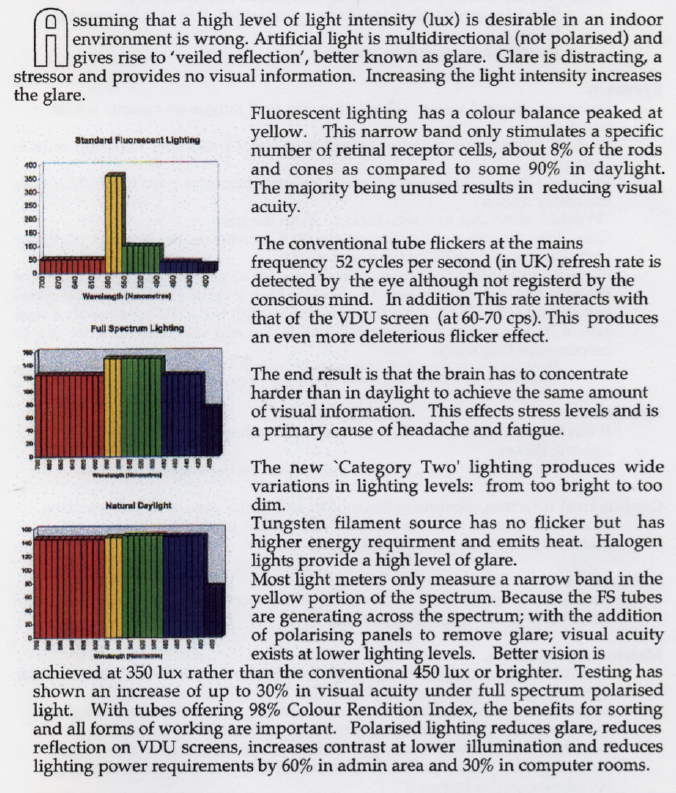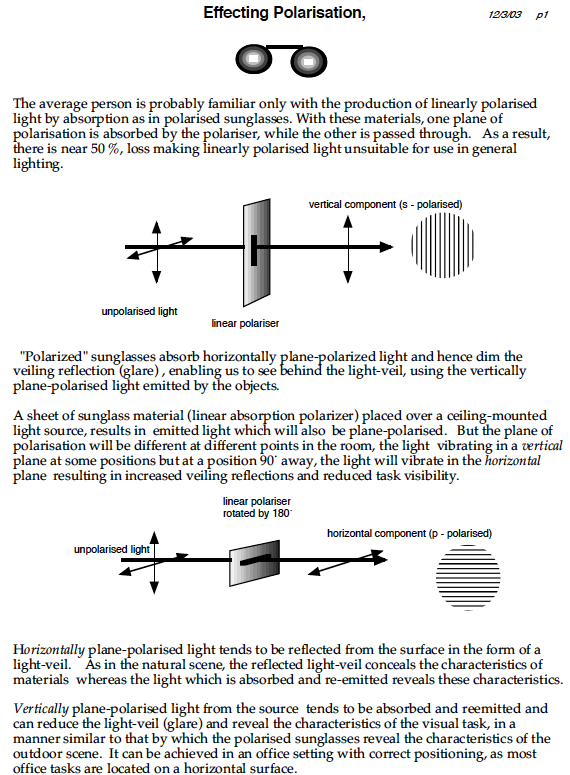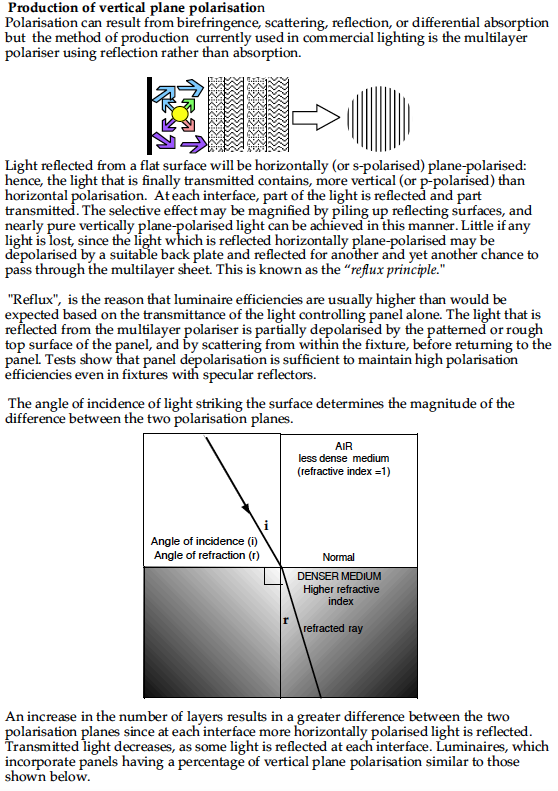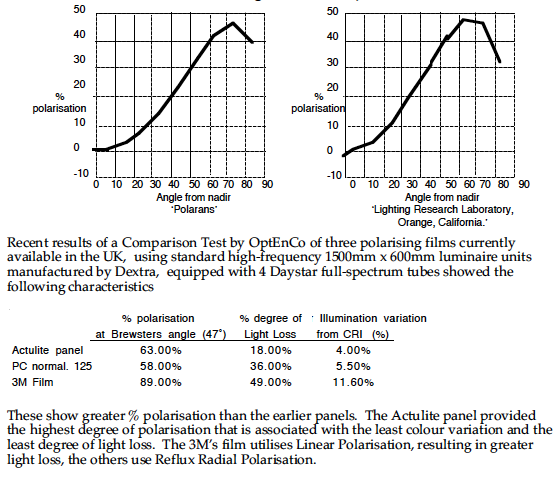Return to →OFFICE HEALTH, Stress & Ergonomics
Assuming that a high level of light intensity (lux) is desirable in an indoor environment is wrong. Artificial light is multidirectional (not polarised) and gives rise to ‘veiled reflection’, better known as glare. Glare is distracting, a stressor and provides no visual information. Increasing the light intensity increases the glare.
Fluorescent lighting has a colour balance peaked at yellow. This narrow band only stimulates a specific number of retinal receptor cells, about 8% of the rods and cones as compared to some 90% in daylight. The majority being unused results in reducing visual acuity.
The conventional tube flickers at the mains frequency 52 cycles per second (in UK) refresh rate is detected by the eye although not registerd by the conscious mind. In addition This rate interacts with that of the VDU screen (at 60-70 cps). This produces an even more deleterious flicker effect.
The end result is that the brain has to concentrate harder than in daylight to achieve the same amount of visual information. This effects stress levels and is a primary cause of headache and fatigue. The `Category Two’ lighting produces wide variations in lighting levels: from too bright to too dim. Tungsten filament source has no flicker but has higher energy requirment and emits heat. Halogen lights provide a high level of glare.
Most light meters only measure a narrow band in the yellow portion of the spectrum. Because the FS tubes are generating across the spectrum; with the addition of polarising panels to remove glare; visual acuity exists at lower lighting levels. Better vision is achieved at 350 lux rather than the conventional 450 lux or brighter. Testing has shown an increase of up to 30% in visual acuity under full spectrum polarised light. With tubes offering 98% Colour Rendition Index, the benefits for sorting and all forms of working are important. Polarised lighting reduces glare, reduces reflection on VDU screens, increases contrast at lower illumination and reduces lighting power requirements by 60% in admin area and 30% in computer rooms.
Daylight, originating in the sun, is full spectrum and is polarised as it traverses the outer layers of the earths atmosphere. This can be replicated indoors by using a ballast to achieve a wide spectrum and a polarising filter.
Symptomatology and morbidity associated with lighting & CRTs.
Stress.
Difficult to define but is associated with increase cortisone blood levels,
HollwichF. Dieckies B . The Effect of natural and Artificial Light via the Eye on the Hormonal and Metabolic Balance of Man and Animals. Munster Univ. ( 100% produced stress levels of ACTH and Cortisone when exposed to fluorescent light.)
To account for this it is postulated that the scan activates stress factors as a response to movement in the peripheral fields. The following three stress effects are measurable using a plathysmograph (‘lie detector’).
- Skin vasoconstriction, results in measurable fall in skin temperature.
- Sweating,
- Heart and pulse rate increased .
Eyestrain.
- Sore eyes, blurred vision. Due to the effects of fatigue on various ocular structures.
- Eyeball movements, as eye detects scan rate. ( saccade, extrinsic muscle fatigue).
- Electron scatter, ‘halo effect’, gives the appearance of poor focus. This tires the ciliary muscle.
- Wobble’ effect due to screen flicker. Tires the iris.
- Glare from fluorescent lighting on the VDU screen results in reflex pupillary contraction and 50-60% loss of visual acuity.
- Fluorescent lighting colour balance is peaked at yellow only activates 8 %of the rods and cones; its reflected light has a high level of glare and the 50 cycles per second (60 , USA) refresh rate interacts with the VDU screen with a scan rate of 70, to produce a tiring subliminal flicker and visual disturbance due to interference frequency.Dodd DD.Human Aspects of Information Technology. UK Min of Defence. 1990. (52% usingcomputers for more than 4 hours a day reported eye symptoms.)
- Headaches. It has been estimated that 50% of work related headaches are caused by lighting flicker.(Wilkins et al. Fluorescent Lighting Headaches and Eyestrain. UK Med Research Council. 1988).
- Conjunctival injection. Results in discomfort and ‘gritty eyes’ and lachrymation. VDU emmision of +ve ions at 7000 v , dc. results in deposition of microparticles on the cornea and sclera.
- Neck and shoulder pain. Secondary musculo-skeletal dysfunction may occur due to efforts to bring the screen into focus by altering posture.
- Melatonin production. Melatonin is supressed by daylight. (Wurtman, R.J., `The effect of light on the human body’~ Scientifc American, 233, 1 Kuller, R., `Non visual effects of light and colour’, Document D 15 (Stockholm, Swedish Council for Building Research) (Wetterberg, L., `Melatonin in humans, Physiological clinical studies’, J Neural Transmission, Suppl 13.º
Background Basic Physics.
Light is propagated by electromagnetic waves. Each colour corresponds to a particular wavelength. All wavelengths have the same velocity in a vacuum, c=3x 1010cm/sec. White light can be split up by a spectroscope into component colours. The band of colours so formed is called the spectrum of the source. Any hot body (e.g. tungsten filament lamp) gives a continuous spectrum. Elements when suitably treated (e.g. in an electric discharge tube) give line emission spectra. Many materials when interposed between source and spectroscope give characteristic absorption spectra. In some respects light behaves as if it were a stream of particles called photons rather than a wave motion, particularly in its photochemical and photo-electric effects and in the phenomenon of fluorescence. The two concepts of light (wave and particle) are complementary and related by: energy of a photo n: where h is Planck’s constant (6.62 x 10-27 erg-sec.). The quantum theory of spectra states that electrons can move in certain orbits only around the parent nucleus. Energy is absorbed or given off in the form of photons as they jump from one orbit to another. The energy of the photon corresponds to a definite wavelength-hence line spectra. Monochromatic radiation is absorbed exponentially. Short wavelengths are much more strongly scattered than long. The inverse square law and cosine law are summarised by:
.Measurement
- Candela = light intensity emited by a stearite candle.
- Lumen. radiation, luminous flux, from a source. 12.5 lumens = 1 candela.
- Lux = 1 lumen per sq ft.
Lighting requirements
- Background. 3-500 lux. With screen work 150-500 can be as low as 50 lux. without screen work should be 750-1,600.
- Task lighting. Controlled 5-800 lux. Tungsten not fluorescent.
- Screen. Ratio screen: desktop: room, should be 1:3:10.
- Vertical down lighting should be sufficient to provide contrast but low enough to avoid pupillary constriction.
- Light source should direct lighting away from VDU screens so as to avoid reflection.
- Ceiling luminaires, 600x600mm…1/50 sq ft, or 1/1.5 employeess.
INDOOR LIGHTING
Daylight, originating in the sun, is full spectrum and is polarised as it traverses the outer layers of the earth’s atmosphere. This can be replicated indoors by using a ballast to achieve a wide spectrum and a polarising filter.
Introduction
Assuming that a high level of light intensity (lux) is desirable in an indoor environment is wrong. Artificial light is multidirectional (not polarised) and gives rise to ‘veiled reflection’, better known as glare. Glare is distracting, a stressor and provides no visual information. Increasing the light intensity increases the glare. Fluorescent lighting has a colour balance peaked at yellow. This narrow band only stimulates a specific number of retinal receptor cells, about 8% of the rods and cones as compared to some 90% in daylight. The majority being unused results in reducing visual acuity.
The conventional tube flickers at the mains frequency 52 cycles per second (in UK, 60 USA) refresh rate is detected by the eye although not registerd by the conscious mind. In addition this rate interacts with that of a CRT screen (at 60-70 cps). This produces an even more deleterious flicker effect.
The end result is that the brain has to concentrate harder than in daylight to achieve the same amount of visual information. This effects stress levels and is a primary cause of headache and fatigue.
Common Lighting systems
To consider the commonlu used lighting systems
- `Category Two’ lighting produces wide variations in lighting levels: from too bright to too dim.
- Tungsten filament source has no flicker but has higher energy requirment and emits heat.
- Halogen lights provide a high level of glare.
Advanced lighting
FULL SPECTRUM POLARISED LIGHTING (FSPL).
Full spectrum allows some 90% of the retinal light receptors (rods & cones) to be stimulated as compared to only 8% at the very narrow frequency towards the yellow portion of the spectrum that an ordinary light bulb emits. The reduced spectrum results in reduced contrast ratios and the end result is that the eyes and brain have to work far harder. This is stressful. The full spectrum colour balance, approximating to that of daylight avoids the distortion caused by other artificial light sources.
- Full Spectrum tubes, generating across the spectrum, allows better visual acuity at lower lighting levels.
- Better vision is achieved at 350 lux rather than the conventional 450 lux or brighter.
Polarisation
The addition of polarising panels, to remove glare, reduces reflection on VDU screens, increases contrast at lower illumination and reduces lighting power requirements by 60% in admin area and 30% in computer rooms. Testing has shown an increase of up to 30% in visual acuity. With tubes offering 98% Colour Rendition Index, the benefits for sorting and all forms of working, particularly with colour, are important.
High Frequency balance
This corrects the flicker of a conventional tube at the mains frequency of 52 cycles. This lower rate is slow enough to interfere with human vision and also clashes with the refresh rate of most VDU’s; producing a double disbenefit, and stress, to computer users.
FULL SPECTRUM POLARISED LIGHTING (FSPL).
This is our recommendation for any workplace environment which requires artifical illumination. Approximating to outdoor conditions, it is shown to increase well-being, increase output and reduce physiological stress.
Symptomatology and morbidity associated with lighting & CRTs.
- Eyestrain.
This consists of ‘Sore eyes’, blurred vision. due to the effects of fatigue on various ocular structures such as the extrinsic muscles.
There is an increase in eyeball movements, as eye detects scan rate. ( saccade, ). Electron scatter, ‘halo effect’, gives the appearance of poor focus. This tires the ciliary muscle and ‘Wobble’ effect due to screen flicker tires the iris.
Glare from fluorescent lighting on the VDU screen results in reflex pupillary contraction and 50-60% loss of visual acuity. Further loss of acuity is due to the narrow band of colour balance with its yellow reflected light giving rise to a high level of glare. The refresh rate interacts with the CRT screen to produce a tiring subliminal flicker and visual disturbance due to interference frequency
- Conjunctival injection. Results in discomfort and ‘gritty eyes’ and lachrymation.
VDU emmision of +ve ions at 7000 v , dc. results in deposition of microparticles on the cornea and sclera.
- Stress.
Conventional fluorescent lighting results in physiological stress. This is associated with increase cortisone blood levels, which can be measured.
To account for this it is postulated that the scan activates stress factors as a response to movement in the peripheral fields in addition to the ‘eyestrain’ effects.
The following three stress effects are measurable using a plathysmograph (‘lie detector’)
- Skin vasoconstriction, results in measurable fall in skin temperature.
- Sweating,
- Heart and pulse rate increased
- Headaches
- It has been estimated that 50% of work related headaches are caused by lighting flicker .
- Neck and shoulder pain.
Secondary musculo-skeletal dysfunction may occur due to efforts to bring the screen into focus by altering posture.
- Melatonin production.
Part of the signal carried by light, received by the eyes and transmitted up the optic nerve reaches the pineal gland. This in turn is connected to the hypothalamus and so to the hormonal control system. The effect of light on the hormonal system is related to the synchronization by melatonin of circadian rhythms with consequent effects on performance, alertness and fatigue and on phenomena such as seasonal affective disorder and jet lag .






